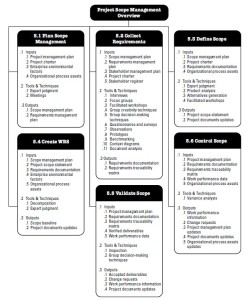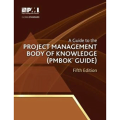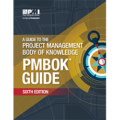
Scope management, or rather the lack of it, is one of the biggest reasons for project failure. Correctly defining what is and is not included in the project is absolutely foundational to good project management. I’ve seen many projects go south even though they had the right expertise, schedule, high quality deliverables, and even satisfied clients. But if the dreaded “scope creep” bug is allowed to fester and multiply, all of your other amazing project accomplishments will be as good as tossed out the window.
As a project manager, you must understand the importance of project scope.
Project scope management is the second knowledge area in the Project Management Institute’s (PMI) Project Management Body of Knowledge (PMBOK). It includes the processes that ensure all of the required work (and only the required work!) is included in the project.
According to the PMBOK, scope management has six processes:
- Plan Scope Management: Planning the process, and creating a scope management plan.
- Collect Requirements: Defining and documenting the stakeholder’s needs.
- Define Scope: Developing a detailed project scope statement.
- Create WBS: Subdividing project deliverables into smaller work units.
- Validate Scope: Formalizing the acceptance of the deliverables.
- Control Scope: The ongoing process of monitoring and managing changes to the project scope.
Plan Scope Management
Newly added into the 5th edition of the PMBOK, this planning step involves the creation of a scope management plan.
Inputs
- Project management plan
- Project charter
- Enterprise environmental factors
- Organizational process assets
Tools & Techniques
- Expert judgment
- Meetings
Outputs
- Scope management plan
- Requirements management plan
Collect Requirements
The success of any project is directly related to the accurate definition and documentation of stakeholder needs. Requirements become the foundation of the Work Breakdown Structure (WBS) in a future step.
Inputs
- Scope management plan
- Requirements management plan
- Stakeholder management plan
- Project charter
- Stakeholder register
Tools & Techniques
- Interviews
- Focus groups
- Facilitated workshops
- Group creativity techniques
- Group decision-making techniques
- Questionnaires and surveys
- Observations
- Prototypes
- Benchmarking
- Context diagrams
- Document analysis
Outputs
- Requirements documentation
- Requirements traceability matrix
Define Scope
At this second step, the requirements are compiled into a scope statement. An example of a scope statement might be:
Inputs
- Scope management plan
- Project charter
- Requirements documentation
- Organizational process assets
Tools & Techniques
- Expert judgment
- Product analysis
- Alternatives generation
- Facilitated workshops
Outputs
- Project scope statement
- Project documents updates
Create WBS
In this section, a detailed work breakdown structure is created, which is a break down of the deliverables into smaller, more manageable work packages. A WBS can take numerous forms, such as division by phases, deliverables, or subprojects. But regardless of how you structure it, the WBS should contain the man-hours, equipment, tools, contractor expenses, and any other item of cost. The WBS is not about the cost; Pricing and cost control are part of the Project Cost Management knowledge area. But the realization of cost helps to ensure you identify every part of a work package.
Inputs
- Scope management plan
- Project scope statement
- Requirements documentation
- Enterprise environmental factors
- Organization process assets
Tools & Techniques
- Decomposition
- Expert judgment
Outputs
- Scope baseline
- Project document updates
Validate Scope
Formalizing of the project deliverables is a task unto itself. In my engineering company, we sometimes give clients a scope statement and ask them to give verbal approval, particularly if it contains many non-standard things (i.e. not just another bridge). Other stakeholders, like landowners around a new development, are given scope statements which may or may not require acceptance depending on the circumstances and stage of the project.
Inputs
- Project management plan
- Requirements documentation
- Requirements traceability matrix
- Validated deliverables
- Work performance data
Tools & Techniques
- Inspection
- Group decision-making techniques
Outputs
- Accepted deliverables
- Change requests
- Work performance information
- Project document updates
Control Scope
Project scope must not only be well defined, but well controlled. Like I said above, “scope creep” trips up many projects and I’ve seen some ugly outcomes. Any changes in stakeholder expectations or requirements during the project’s execution must be integrated into a new scope statement and work breakdown structure. The associated cost, time, and resource changes must be itemized and managed.
Inputs
- Project management plan
- Requirements documentation
- Requirements traceability matrix
- Work performance data
- Organization process assets
Tools & Techniques
- Variance analysis
Outputs
- Work performance information
- Change requests
- Project management plan updates
- Project documents updates
- Organizational process assets updates
Do you have anything to add? I’d love to hear your comments about scope management in the comments section below.








This is one of the best resources I’ve come across in terms of studying for the PMP. Many of the study materials I am finding are over-written, or unorganized to the point where it is hard to follow. I am sure study material is dependent on personality, but for me this is the clearest, most streamlined study sheet for a process I have found.
Please i want to know how to do a scope management plan with examples given to illustrate. I dont got any clear image of this course.